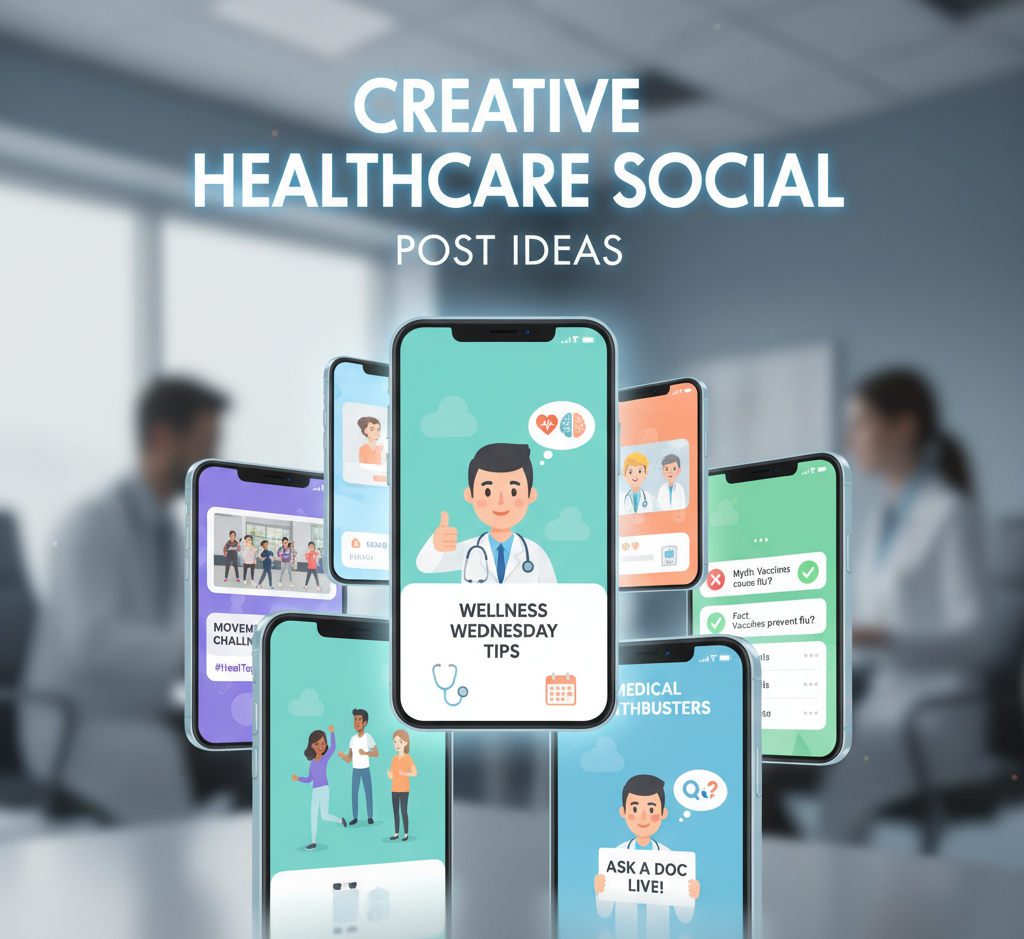Healthcare businesses can’t rely on word-of-mouth alone. Patients are online, searching for medical advice, trustworthy doctors, and local clinics that can help them quickly. Social media is now one of the most powerful ways to build credibility, connect with patients, and grow your healthcare brand. But creating content that is both educational and engaging can be a challenge.
This guide breaks down practical social media post ideas for healthcare, including examples, content angles, and design inspiration for hospitals, doctors, clinics, and mental health professionals.
Why Social Media Matters for Healthcare Businesses
For hospitals, clinics, and medical practices, social media has shifted from being optional to essential. People use Facebook, Instagram, and even LinkedIn to find healthcare solutions, check reviews, and gauge how credible a medical facility looks before booking an appointment.
Social platforms also allow healthcare brands to educate people, correct misinformation, and showcase their services without sounding overly promotional.
Some major benefits include:
- Increased trust: Patients see consistent, helpful posts from your clinic and start viewing you as an expert.
- More patient inquiries: You stay top of mind when someone needs a medical consultation.
- Improved reputation: Social proof through testimonials and behind-the-scenes posts helps build brand credibility.
- Better engagement: People appreciate authentic, caring healthcare professionals online.
Now, let’s move into what to actually post.
1. Medical Social Media Post Ideas
Medical social media posts should balance education, awareness, and patient connection. Here are several content types that work effectively:
Health Awareness Tips
Post short, easy-to-read health tips for common issues like flu prevention, healthy eating, or exercise routines. Use infographics, quick reels, or carousel posts to make them engaging.
Example:
- “3 simple ways to boost your immune system this winter.”
- “Why hydration is more important than you think.”
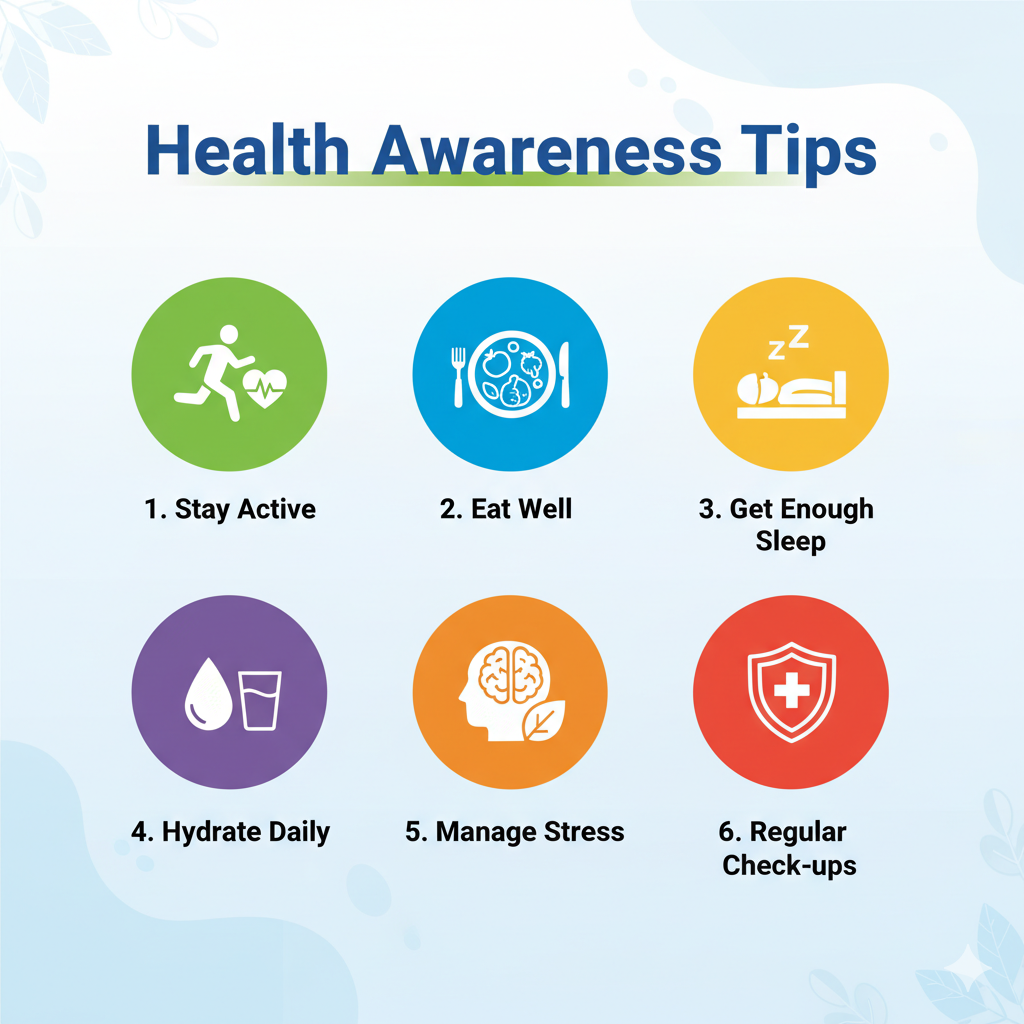
Disease Awareness Campaigns
Create awareness around health days like World Diabetes Day or Breast Cancer Awareness Month. Use branded templates and add educational captions.
Example:
- “October is Breast Cancer Awareness Month. Early detection saves lives. Book your screening today.”
Preventive Care Posts
Highlight preventive measures for common diseases. Many patients don’t visit doctors until issues get worse; these posts encourage early care.
Example:
- “A routine blood test every 6 months can detect hidden problems before symptoms appear.”
Staff Introduction Posts
Introduce doctors, nurses, and administrative staff. Show their expertise and friendly side to make your healthcare brand feel human.
Example:
- “Meet Dr. Ahmed, our cardiology expert with 15 years of experience saving lives.”
Behind-the-Scenes
Share what happens inside your clinic, from equipment sanitization to staff meetings. These posts build trust and transparency.
2. Hospital Social Media Post Design Ideas
Hospitals can appear too formal or intimidating online, so your design and content should make patients feel comfortable and confident.

Use Soothing Colors
Stick to calm tones like blue, white, and green. These colors symbolize trust, cleanliness, and care. Avoid overly bright or dark designs.
Consistent Branding
Use your hospital’s logo, name, and consistent typography in all posts. Consistency creates recognition; patients start identifying your posts instantly.
Testimonials and Success Stories
Showcase patient recovery stories (with consent). Use before-and-after formats or testimonial videos.
Example Caption:
“After months of back pain, Mr. Usman found relief through our physiotherapy program. Here’s his story.”
Doctor Quotes
Design posts featuring doctors’ advice or motivational quotes about health. It boosts credibility and engagement.
Example:
“Prevention is better than cure, always listen to what your body tells you.”
Facilities Showcase
Highlight hospital rooms, advanced equipment, or new departments. Visual transparency builds trust among potential patients.
3. Social Media Posts for Doctors
Individual doctors can build strong personal brands using social media. Patients today follow doctors they trust and seek advice from them online.
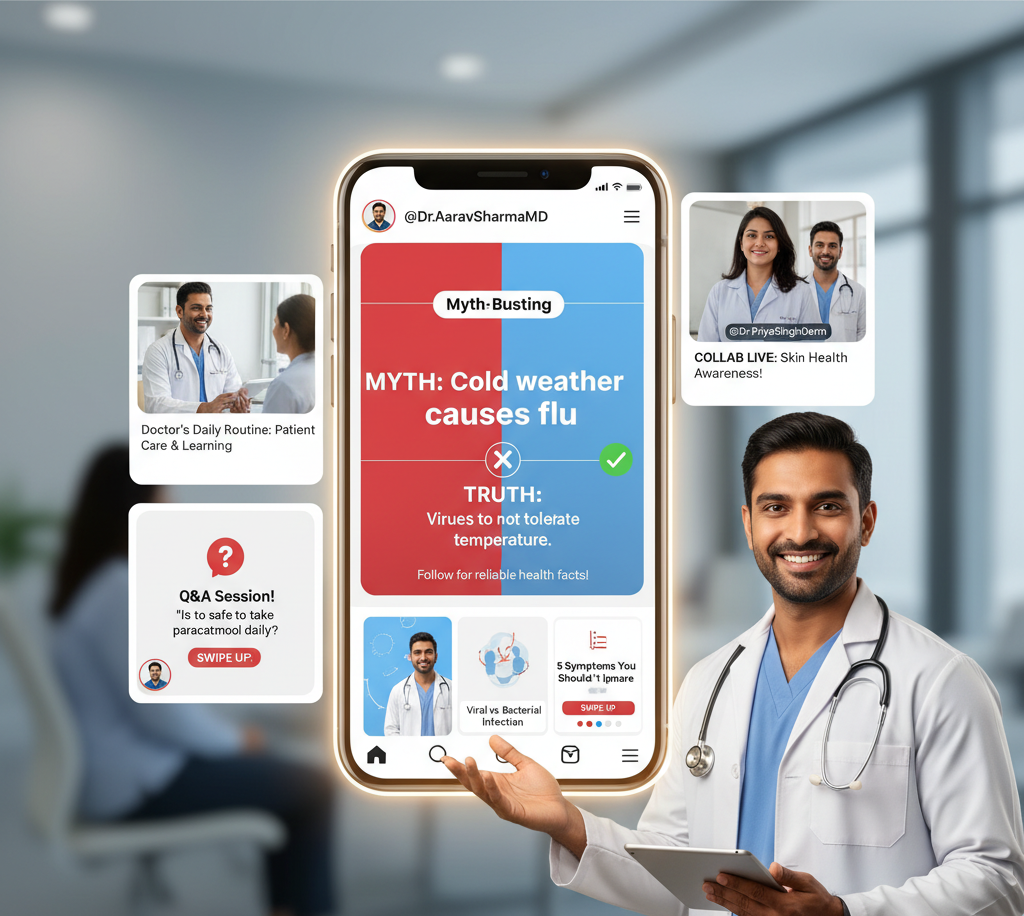
Myth-Busting Posts
Share common health myths and clarify the facts. This positions you as a reliable source of truth.
Example:
- “Myth: Cold weather causes flu. Truth: Viruses do not tolerate temperature.”
Q&A Sessions
Host a live session or post answers to FAQs.
Example:
- “Is it safe to take paracetamol daily? Here’s what you should know.”
Educational Carousels
Post detailed guides like “5 Symptoms You Shouldn’t Ignore” or “Difference Between Viral and Bacterial Infection.”
Doctor’s Daily Routine
Humanize your online presence by sharing bits of your routine, consultations, patient care, or continuing education events.
Collaboration with Other Specialists
Tag and collaborate with other doctors for joint videos or awareness posts. This builds authority and expands your reach.
4. Medical Post Design Ideas
When designing medical posts, clarity and trust should be your focus. Your visuals should reflect expertise, not sales.
Use Real Images Where Possible
Avoid overused stock photos. Authentic photos of doctors and real patients (with consent) look more genuine.
Keep Text Readable
Don’t clutter your design with too much text. Highlight key words, keep font professional, and make sure it’s readable on mobile.
Infographic Designs
Turn complex medical data into simple infographics; people love saving and sharing them.
Icons and Illustrations
Use icons for organs, medicines, and health symbols. Minimal illustrations make medical posts easier to understand.
Seasonal Designs
Create visuals around seasonal topics, like flu shots in winter, dehydration prevention in summer, or allergy awareness in spring.
5. Medical Post Design Template Tips
If you want your hospital’s social media to look professional and consistent, templates are your best friend.
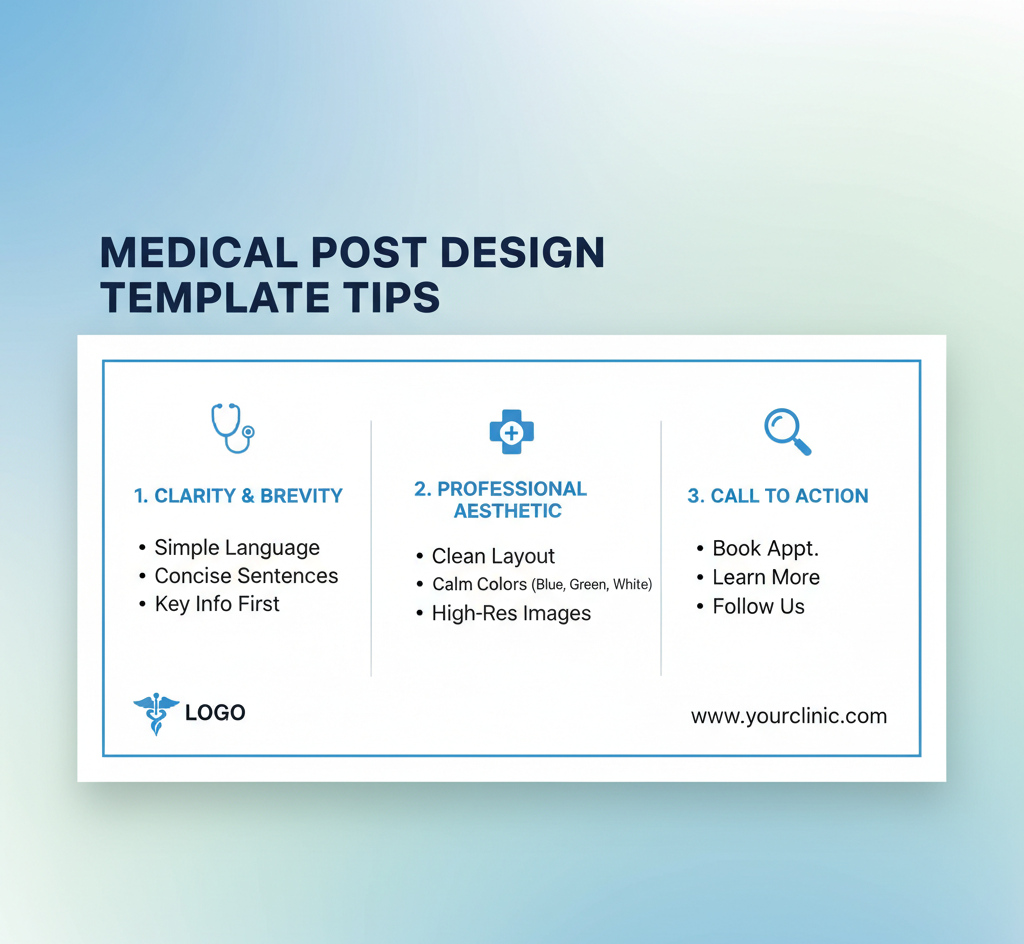
Create a Template Set
Use tools like Canva or Adobe Express to make templates for different post types, awareness, tips, promotions, etc.
Keep Branding Subtle but Visible
Place your logo in the same position every time. Use your brand’s primary colors to create consistency.
Include a CTA Area
Design a clean space at the bottom for CTAs like “Book Appointment” or “Call Now.”
Save Time with Ready Layouts
Once you create templates for major categories, posting becomes much faster; your team only needs to update content and images.
6. Healthcare Social Media Ideas
Beyond regular posts, think of creative ways to keep your followers engaged and informed.
Patient Journey Stories
Share how patients overcame health challenges with your team’s help. Use storytelling rather than promotion.
Health Quizzes and Polls
Make engagement posts fun, quizzes like “Can you guess the healthiest fruit?” or polls like “Do you take multivitamins daily?”
Video Testimonials
Short video reviews build more trust than text testimonials. Feature patients or family members expressing gratitude.
Awareness Campaigns
Run monthly campaigns focusing on different medical areas, e.g., “Heart Health February” or “Dental Care August.”
e. Quick Tips Reels
Make short videos (10–15 seconds) showing quick, valuable tips. Example:
“Did you know 80% of diseases can be prevented through simple lifestyle habits?”
7. Mental Health Social Media Post Ideas
Mental health deserves equal attention in your content strategy. It’s one of the most searched healthcare topics online.
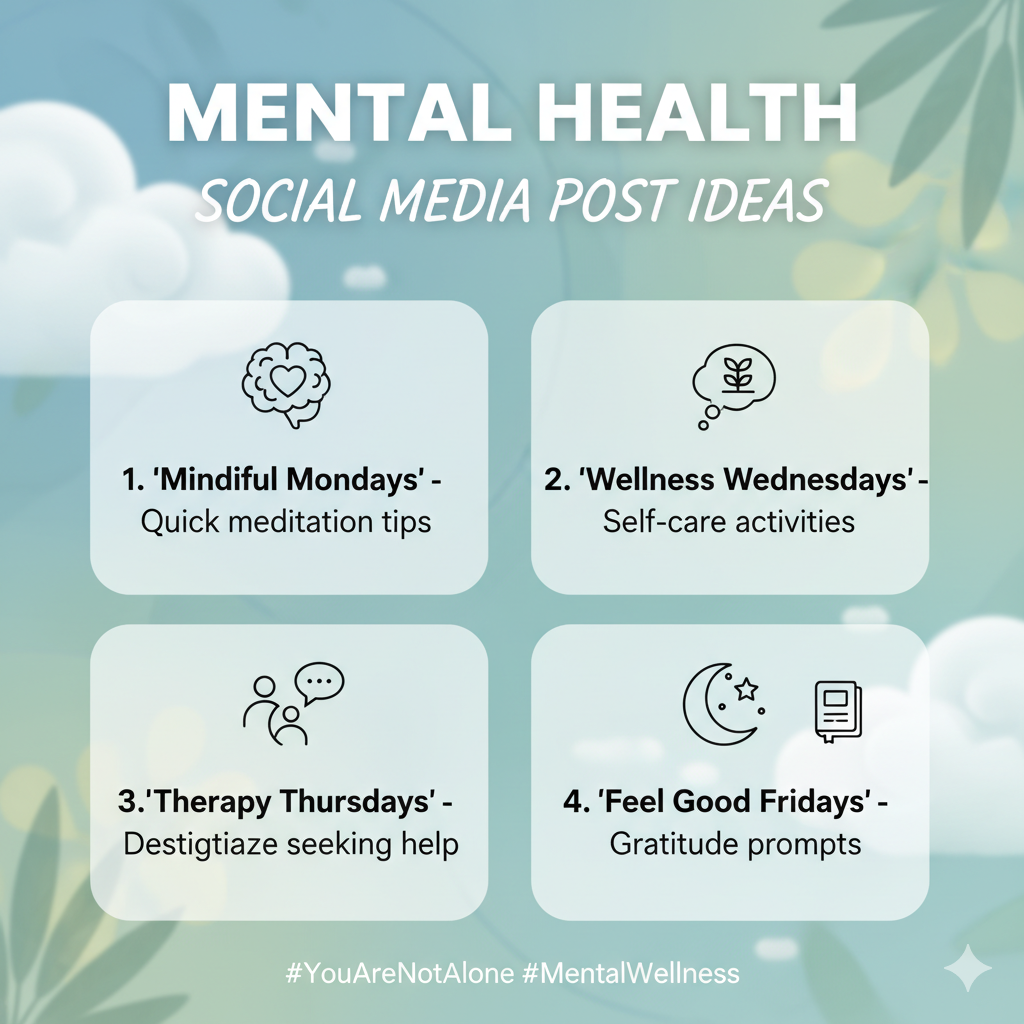
Break the Stigma
Post awareness content that normalizes mental health discussions.
Example:
“It’s okay to ask for help. Mental health matters as much as physical health.”
Self-Care Tips
Share realistic self-care activities like journaling, deep breathing, or meditation.
Therapy Education
Explain what therapy sessions are like and address common misconceptions.
Motivational Quotes
Positive reminders perform very well. Example:
“Healing is not linear, and that’s okay.”
Mental Health Days
Highlight World Mental Health Day and similar observances with useful resources or awareness campaigns.
8. Common Mistakes in Healthcare Social Media Marketing
Many medical professionals fail to get results from social media because they either oversell or post irregularly.
Avoid these mistakes:
- Posting only promotional offers without educational value.
- Using poor-quality graphics or long captions filled with jargon.
- Ignoring comments and messages from patients.
- Copying competitors’ content without originality.
- Failing to verify medical facts before posting
Your audience values accuracy and empathy more than flashy designs.
9. Content Planning for Healthcare Pages
To make your social media marketing consistent and organized:
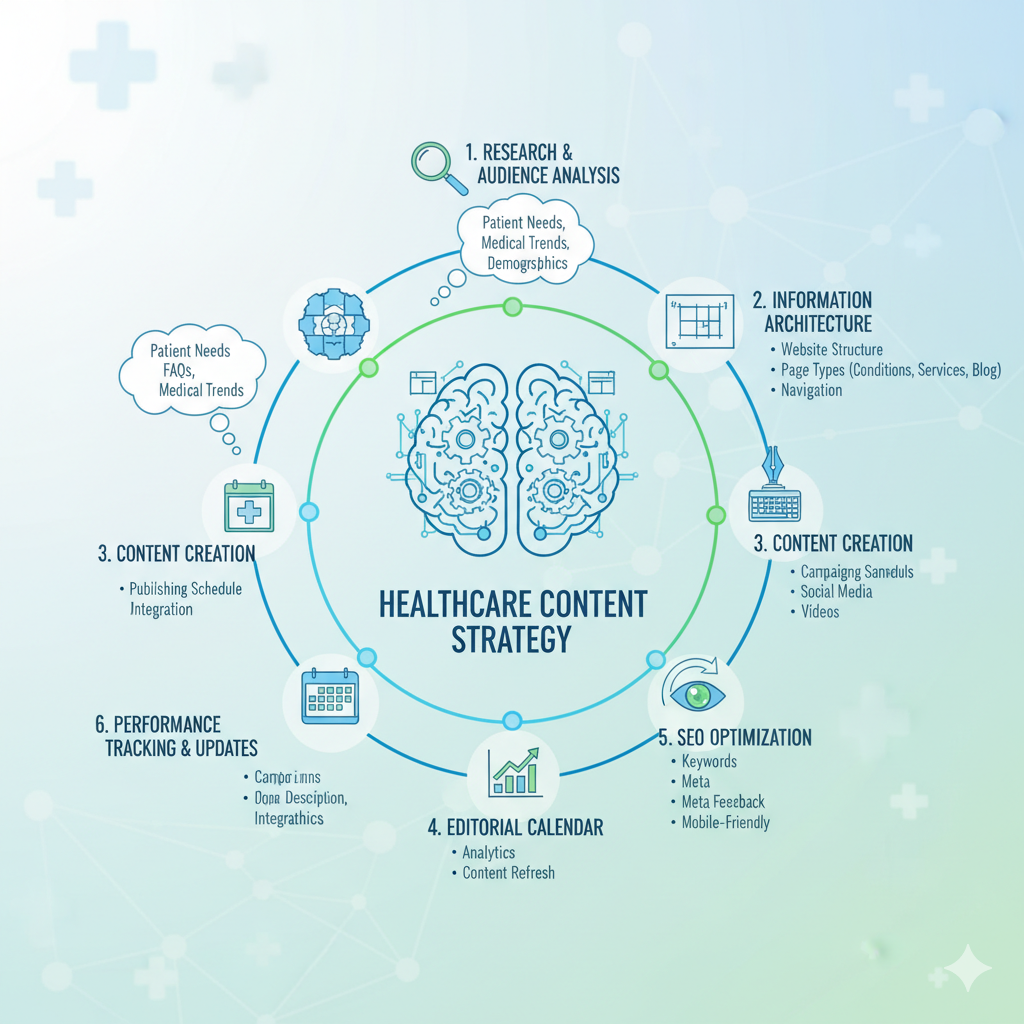
Set Weekly Themes
Example:
- Monday: Health Tip
- Wednesday: Doctor’s Insight
- Friday: Patient Story
Use Scheduling Tools
Tools like Buffer or Meta Business Suite help you schedule and monitor performance.
Track Engagement
Check which posts perform best and adjust your strategy accordingly. Educational videos and personal stories usually outperform ads.
10. Tips for Writing Captions for Medical Posts
Even a great design can fail if your caption isn’t engaging.
Start with a Hook
Ask a question or share a relatable fact.
Example:
“Do you know most people ignore these early signs of diabetes?”
Keep It Simple
Avoid medical jargon. Write in a way that non-specialists can easily understand.
Add Value
Every caption should teach something, inspire, or motivate readers to act.
Include Hashtags
Use hashtags like #HealthcareTips, #MedicalAwareness, or #HealthyLiving to reach more people.
11. Advertising Healthcare Services on Social Media
While organic content builds trust, paid advertising helps you reach more patients.
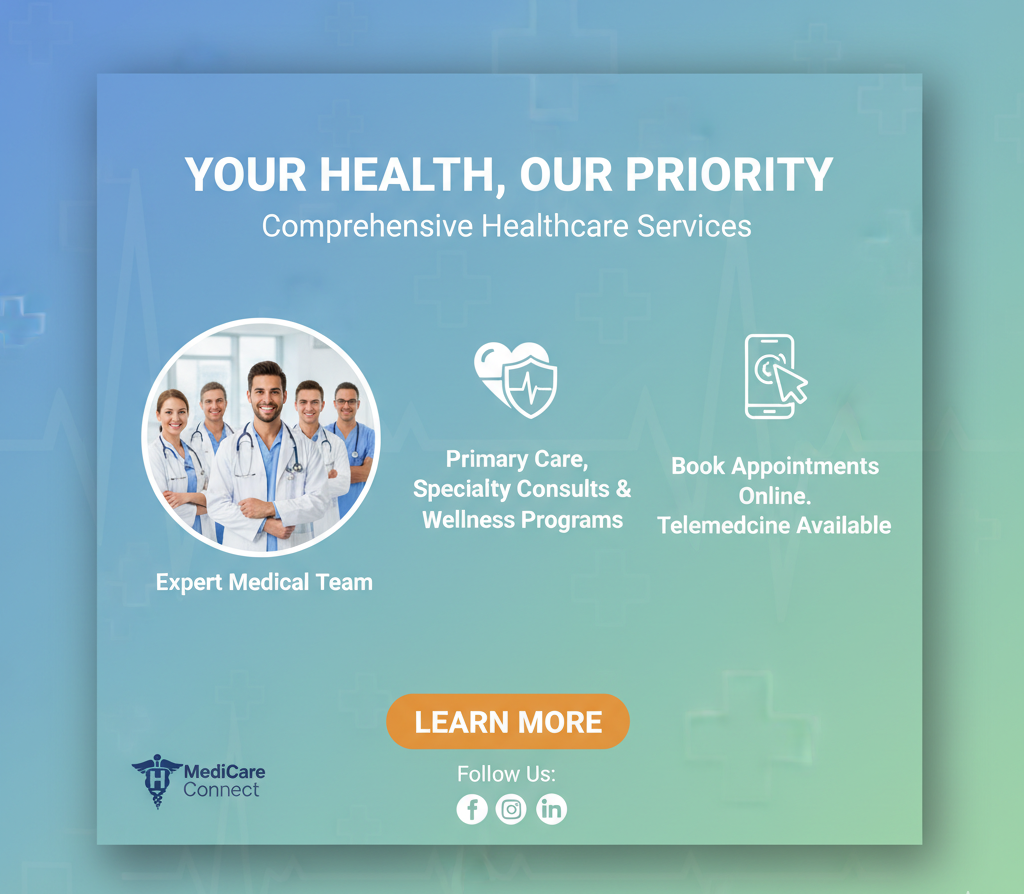
Promote Awareness Campaigns
Run ads around health checkup packages or awareness months.
Geo-Targeted Ads
Target people within your city or a specific radius. For example, “Within 5 km of your hospital.”
Retarget Website Visitors
Remind visitors who previously viewed your site to book an appointment.
Use Video Ads
Short, emotional patient stories or doctor introductions make effective ad creatives.
12. Building Trust Through Consistency
Consistency is the backbone of successful healthcare marketing. Patients are more likely to remember and trust clinics that post regularly and maintain the same voice.
- Keep your tone compassionate and informative.
- Maintain a uniform posting schedule.
- Avoid trends that don’t align with your brand identity.
Over time, consistent visibility creates authority, especially when paired with patient satisfaction posts and verified testimonials.
14. Final Thoughts
Healthcare marketing is no longer about pushing services; it’s about building credibility, educating patients, and creating lasting trust. With thoughtful social media post ideas for healthcare, hospitals, and clinics can strengthen their relationships with communities, increase awareness, and attract the right patients.
Focus on clarity, empathy, and accuracy. Whether you’re posting medical social media tips, designing hospital post templates, or sharing mental health awareness content, always ensure your content serves the audience first, not just your brand.
Grow Your Healthcare Brand with Professional Digital Marketing
If you run a hospital, clinic, or healthcare practice and want to attract more patients online, our digital marketing services can help. At Brandout, we specialize in creating targeted healthcare marketing strategies that deliver measurable results.
From managing Facebook and Google Ads to crafting impactful social media campaigns and SEO-optimized medical content, we help your healthcare business stand out and convert more leads.
Reach out to Brandout today and discover how a smart, transparent marketing plan can help your healthcare brand grow with trust and consistency.

